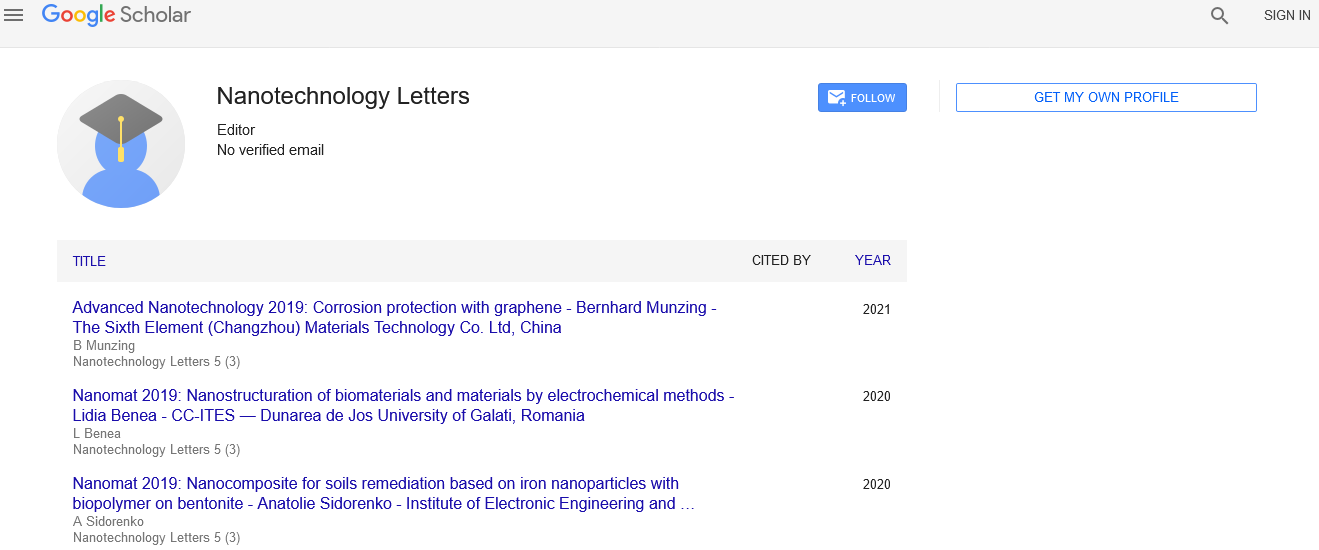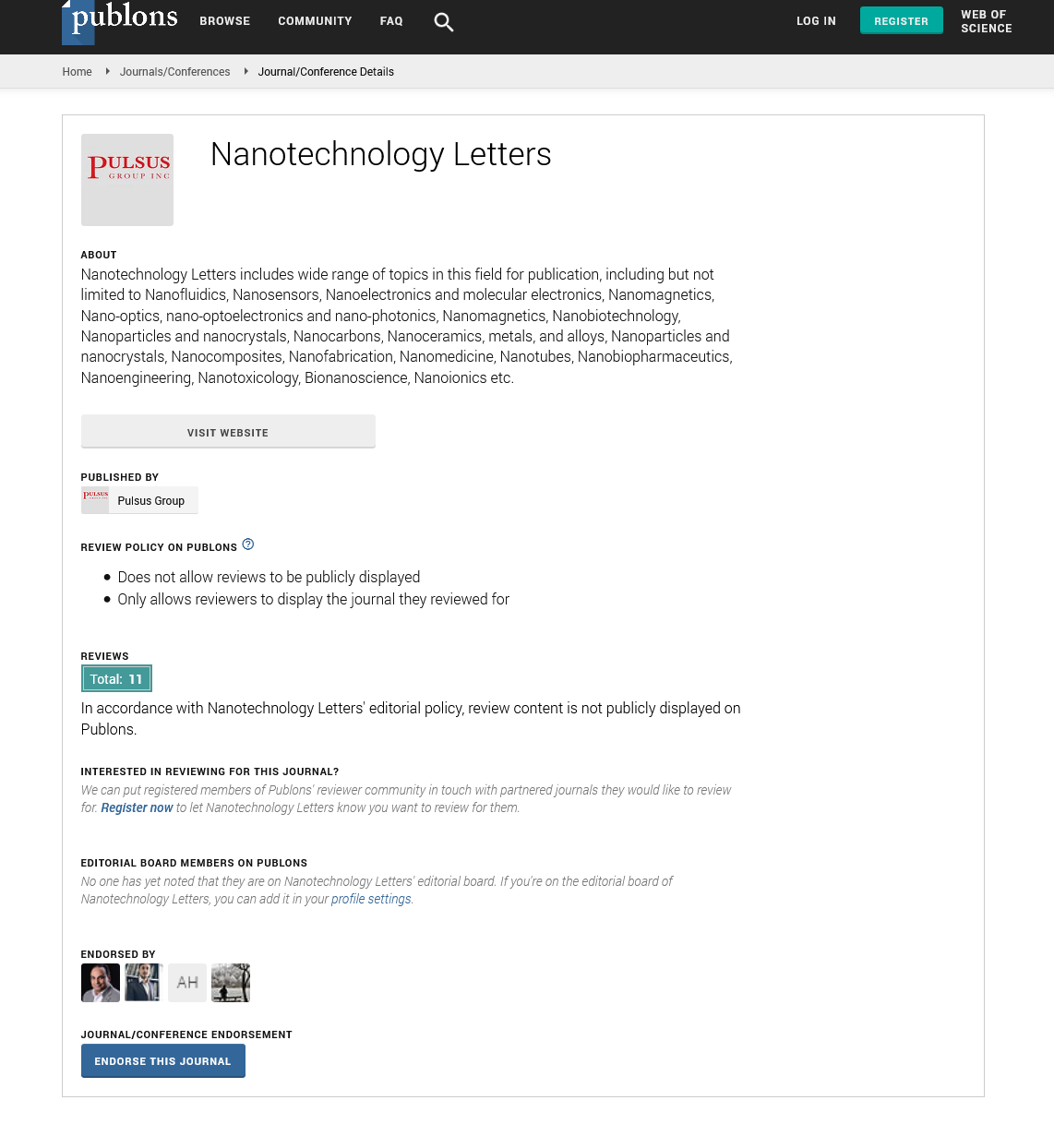Role of hybrid porous nanoparticles in environment
Received: 05-Nov-2022, Manuscript No. PULNL-22- 5837; Editor assigned: 08-Nov-2022, Pre QC No. PULNL-22- 5837 (PQ); Accepted Date: Nov 28, 2022; Reviewed: 15-Nov-2022 QC No. PULNL-22- 5837 (Q); Revised: 17-Nov-2022, Manuscript No. PULNL-22- 5837 (R); Published: 29-Nov-2022, DOI: 10.37532. pulnl.22.7 (6)26-27
Citation: Watson S. Role of hybrid porous nanoparticles in environment Nanotechnol. lett.; 7(6):26-27
This open-access article is distributed under the terms of the Creative Commons Attribution Non-Commercial License (CC BY-NC) (http://creativecommons.org/licenses/by-nc/4.0/), which permits reuse, distribution and reproduction of the article, provided that the original work is properly cited and the reuse is restricted to noncommercial purposes. For commercial reuse, contact reprints@pulsus.com
Abstract
It was early recognised that, in addition to their advantageous features, nanoparticles may pose a risk to human health and the environment due to the rapid production of new nanomaterials. Over the past 20 years, evidence has gathered in favour of oxidative stress as a general mechanistic theory to explain how manufactured nanoparticles interact with biological molecules. Since oxidative stress was acknowledged in redox biology as a physiological response, its extensive use in nanotoxicology has revealed new difficulties and restrictions.
Keywords
Oxidative stress; Redox potential; Nanotoxicology; Nanoparticle
Introduction
The category of contemporary high technologies now includes nanotechnology. It was early recognised that, in addition to their beneficial features, nanoparticles may pose a risk to human health and the environment due to their rapid development [1]. As a result of this awareness, the independent field of nanotoxicology developed and became crucial to the development of nanotechnology. Over the past 20 years, strong evidence has accumulated in favour of Oxidative Stress (OS) as a general mechanistic paradigm underlying the interaction of extremely small engineered particles with biological objects. Redox biology had long identified OS as a physiological response concept before nanotechnology [2]. Its extensive usage in nanotoxicology experiments consequently revealed fresh difficulties and constraints.
Multiple electron transfers from high to low energy entities are necessary for aerobic organisms to function, with oxygen serving as the last electron acceptor and a powerful oxidant with a formal potential of E=0.82 V compared to a standard Hydrogen Electrode (NHE). Dioxygen reactivity is fortunately fairly low without further activation due to the quantum mechanical constraints in the electronic ground state, which prevents the spontaneous combustion of organic material. As a result, numerous redox reactions can take place along the slope of decreasing electronic energy, with the rates being regulated by specific enzymatic structures. Redox homeostasis, which keeps each cellular compartment's redox potential within a "healthy" physiological range, is also known as OS. OS is defined as a supra-physiological movement to higher potential values.
Hydrogen peroxide, which builds up during the respiratory burst, is a significant generator of radicals in a biological environment. When oxygen is broken down, ROS are created both internally and externally, primarily in the mitochondria. The formal redox potential and reaction kinetics of ROS with a particular biological partner serve to best express their oxidising strength, which is inverse to their lifetime. Depending on the severity of the OS, the body's natural homeostasis steps in to adjust, which activates inflammatory signalling and internal antioxidant responses. In extreme circumstances, OS may cause apoptosis, necrosis, or ferroptosis, which would kill the cells. When ROS interact with biomacromolecules on a molecular level, specific pathological outcomes, like atherosclerosis and cancer, result. In the activation of specific cellular signalling pathways, nuclear transcription factors, and pathogen detoxification, naturally occurring ROS play crucial physiological roles.
Oxidative stress
Although OS is a key mechanistic notion in nanotoxicology, because to the enormous variety of physicochemical features of Nanoparticles (NPs), numerous biological routes are where it originates. The comparison between laboratories is hampered by the typical qualitative or relative presentation of ROS measurement results. Nevertheless, distinctive OS starting features have appeared in a number of nanomaterial types and can offer a physical foundation for modelling the NP danger. Using the position of their electronic energy bands in relation to the intracellular redox potential range, Burello et al. have suggested a theory linking metal oxide electronic structure to possible toxicity.
An advantageous NP conduction or valence band position encourages electron exchanges between a metal oxide NP and a nearby biomolecule, resulting in OS. In a subsequent comprehensive investigation using a number of metal oxide NP tests with zebra fish, this framework was validated [3]. In a biological context, metallic NPs can be reduced, oxidised, and release metal ions [4], mostly depending on their formal redox potential value in comparison to the typical biological redox potential range, which ranges from 0.38 V to +0.34 V [5]. Without being complexed, certain metal ions (Fe, Cu, Cr, and Co) encourage redox cycling and permit Fenton-type reactions with hydrogen peroxide, which result in the production of OH, an incredibly reactive (E=2.8 V) and fleeting (=1 ns) radical.
Depending on where they are, NPs can interact with the extracellular media, transmembrane proteins by triggering intracellular signalling, or after their internalisation through a variety of recognised mechanisms to produce OS [6]. When NPs are absorbed by the cell, they come into contact with different biomolecules and may disturb the redox balance in the cytosol and organelles. By preventing or delaying oxidative reactions in a biological environment, as well as acting as radical scavengers, NPs can also serve as antioxidants. These advantageous properties are actively sought after for potential therapeutic applications in nanomedicine [7]
Nanomaterial-induced OS measurement
The most popular experimental in vitro method in OS caused by nanomaterials The most popular experimental in vitro method for measuring the oxidative stress caused by nanomaterials includes incubation with NPs. This is followed by evaluations of the oxidative damage to biomacromolecules like DNA, lipids, and proteins or cellular antioxidant defences [8]. One can determine the relative amount of the NP-caused OS by comparing it to the non-exposed control group (also known as the "negative control"). An estimation of the upper OS limit is provided by in vitro tests using a positive control drug that is known to be hazardous. It is possible to estimate the dynamic range for the assay output by using both positive and negative controls. The positive control must represent a comparable material class, such as metal oxides, metals, etc., in order to be meaningful. Many assays designed to detect OS were previously created for soluble compounds and medicines, and they often need to be modified for usage in the presence of NPs in order to prevent producing incorrect findings when a specific substance is present. The majority of additional difficulties can be attributed to undiscovered particle interactions with assay components [9], test biomolecules and nutrients , or interferences with the assay optical readout . Due to the NPs' inherent light scattering, absorption, and emission, optical problems arise. Additionally, NP's chemical make-up, aggregation state, and surface coating determine their optical qualities and biological activity. All of these factors could be changed throughout the test process, for as by adding them to the cell culture medium. Determining the NPphysico-chemical characteristics in a biological test is therefore crucial.
If care are not taken to prevent exposure to ambient light, photocatalytic NPs, such as TiO2, may create ROS in acellular settings and increase the macromolecular damage during the test method . NPs have been demonstrated to impede DNA migration during electrophoresis, generating false negative results when evaluating DNA strand breakage with the single cell gel electrophoresis (akacomet) assay [10]. A fairly sensitive early OS indicator is variation in reduced Glutathione (GSH), which can be found using absorbance with Ellman's reagent or by using an organo-selenium probe based on rhodamine. However, the presence of metallic NPs will significantly stifle probe light emission.
The assays used to evaluate antioxidant production and macromolecule damage generally consume the sample, making it impossible. This might make it more difficult to evaluate the OS under conditions of prolonged, low-dose NP exposure. Using microscopic imaging with fluorogenic sensors to monitor ROS and antioxidant levels in living cells, it is possible to observe OS progression in real time and prevent artefacts from sample extraction. Following developments in high-content analytical technologies, the use of gene expression analysis to discover underlying OS processes brought on by exposure to NPs is growing.
Techniques such as gene chips and reverse transcription polymerase chain reaction allow the recognition of early molecular markers of the redox imbalance by following the expression of genes, responsible for the antioxidant proteins.
References
- Donaldson K, Stone V, Tran CL, et al. Nanotoxicology. Occup environ med. 2004;61(9):727-8. [Google scholar] [Crossref]
- Li N, Xia T, Nel AE, et al. The role of oxidative stress in ambient particulate matter-induced lung diseases and its implications in the toxicity of engineered nanoparticles. Free radic biol med.2008;44(9):1689-99. [Google scholar] [Crossref]
- Sarkar A, Ghosh M, Sil PC. Nanotoxicity: oxidative stress mediated toxicity of metal and metal oxide nanoparticles. J nanosci nanotechnol. 2014;14(1):730-43. [Google scholar] [Crossref]
- Blake D, Hall N, Bacon P, et al. The importance of iron in rheumatoid disease. Lancet. 1981;318(8256):1142-4. [Google scholar] [Crossref]
- Gutteridge JM, Richmond R, Halliwell B et al. Oxygen free‐radicals and lipid peroxidation: Inhibition by the protein caeruloplasmin. FEBS letters. 1980;112(2):269-72. [Google scholar] [Crossref]
- Halliwell B. Biochemistry of oxidative stress. Biochem. soc. trans.2007 Nov 1;35(5):1147-50. [Google scholar] [Crossref]
- Burello E, Worth AP. A theoretical framework for predicting the oxidative stress potential of oxide nanoparticles. Nanotoxicology. 2011;5(2):228-35. [Google scholar] [Crossref]
- Lin S, Zhao Y, Xia T, et al. High content screening in zebrafish speeds up hazard ranking of transition metal oxide nanoparticles. ACS nano. 2011;5(9):7284-95. [Google scholar] [Crossref]
- Auffan M, Rose J, Wiesner MR, et al. Chemical stability of metallic nanoparticles: a parameter controlling their potential cellular toxicity in vitro. Environ Pollut. 2009;157(4):1127-33. [Google scholar] [Crossref]
- Plumlee GS, Morman SA, Ziegler TL, et al. The toxicological geochemistry of earth materials: an overview of processes and the interdisciplinary methods used to understand them. Rev Mineral Geochem. 2006;64(1):5-7.[Google scholar] [Crossref]






